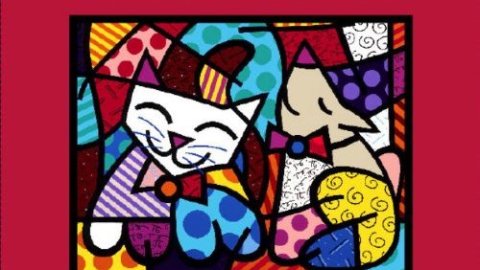C’mon, Get Happy!: Romero Britto’s “Happy!”

“I am an optimist,” Brazilian-born artist Romero Britto writes in the introduction to his new book Happy! “I know that isn’t a common trait to have these days, but I just can’t help myself.” When the blues strike you hard, the art of Britto—full of bold color and luscious textures—can soften the blow and, even better, heal the wounds. You’ll find yourself unable to help smiling yourself and to share the shiny glimmer of Britto’s optimism when turning the pages of Happy!
Art always reflects the age in which it is made. The angst of the twentieth century tainted the worldview of modernism darkly. The specter of terrorism looms over the twenty-first century and glooms every moment. We’re so preconditioned to see art as a troubled mirror image of our world that images full of hope, optimism, and unfettered joy strike us as odd or, even sadder, as childish. That’s childish, not the more positive childlike. Britto’s paintings often feature cutesy cats and dogs, but the message of joy is one adults should hear just as often as children do. When Britto catalogues things that make us happy, he includes the unfeigned joys of children at play as well as the mature joys of two people falling in love.
Art lovers will find themselves thinking of Chagall when looking at Britto’s paintings. The conjugal bliss of Chagall’s best wedding scenes even at their best never fully lose the tragic undertones of the Jewish experience of the last century. Similarly, when Picasso painted at his simplest and approximated a child’s eye, you never could shake the memory of Guernica lurking in the back of your mind. Britto, by contrast, sings an electric song of happiness with no hidden notes of tragedy or sadness. You may call him a one-note wonder, but that single note cuts through the white noise of modern life in all its cruelty and rejection.
Britto accepts the world in his work. He asks you to do the same. Happy! looks and feels like a children’s book in your hands, but it’s really written and painted with the adult heart in mind. Survivors of the 1970s remember the saccharine sounds of The Partridge Family urging us to “C’mon, get happy!” Britto never gets saccharine. The sweetness of Britto’s paintings and unalloyed optimism makes the bitterness of living in the world today a little more palatable to those who allow themselves a taste of his art.
[Many thanks to Rizzoli for providing me with a review copy of Romero Britto’s Happy!]





